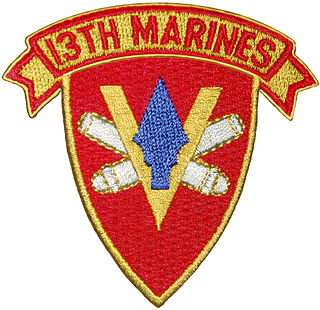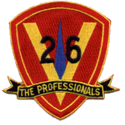
The 3rd Marine Division is an infantry division of the United States Marine Corps based at Camp Courtney, Marine Corps Base Camp Smedley D. Butler and Okinawa, Japan. It is one of three active duty infantry divisions in the Marine Corps and together with the 1st Marine Aircraft Wing (1stMAW) and the 3rd Marine Logistics Group forms the III Marine Expeditionary Force. The division was first formed during World War II and saw four years of continuous combat in the Vietnam War. Today, elements of the 3rd Marine Division are continuously forward deployed and forward postured to carry out the US Government's mission of a Free and Open Indo-Pacific in conjunction with its sister services.

The 5th Marine Division was a United States Marine Corps ground combat division which was activated on 11 November 1943 at Camp Pendleton, California during World War II. The 5th Division saw its first combat action during the Battle of Iwo Jima in 1945 where it sustained the highest number of casualties of the three Marine divisions of the V Amphibious Corps. The 5th Division was to be part of the planned invasion of the Japan homeland before Japan surrendered. Assault troops of the 5th Division were included in the Presidential Unit Citation awarded to the V Amphibious Corps for extraordinary heroism on Iwo Jima from 19 to 28 February 1945. The 5th Division was deactivated on 5 February 1946.

Marine Medium Tiltrotor Squadron 364 (VMM-364) is a United States Marine Corps medium-lift tiltrotor squadron consisting of MV-22B Ospreys. The squadron, known as the "Purple Foxes", is based at Marine Corps Air Station Camp Pendleton, California and falls under the command of Marine Aircraft Group 39 (MAG-39) and the 3rd Marine Aircraft Wing.

2nd Battalion, 23rd Marines (2/23) is a reserve infantry battalion in the United States Marine Corps located throughout the Western United States consisting of approximately 1000 Marines and Sailors. They fall under the command of the 23rd Marine Regiment and the 4th Marine Division.

The 9th Marine Regiment was an infantry regiment of the United States Marine Corps. Formed during World War II, it served until 1994, when it was deactivated during the post Cold War drawdown. Battalions of the Ninth Marine Regiment, but not the regiment itself, were reactivated from 2007 to 2014 as part of the Marine Corps' growth during the wars in Iraq and Afghanistan. The battalions have subsequently been deactivated again.

1st Battalion 12th Marines (1/12) is an artillery battalion comprising three firing batteries and a Headquarters Battery. The battalion is stationed at Marine Corps Base Hawaii and falls under the 12th Marine Regiment and the 3rd Marine Division. The battalion has recently transitioned to its new primary weapon system the M777 lightweight howitzer with a maximum effective range of 30 kilometres (19 mi).

The 27th Marine Regiment is an inactivated infantry regiment of the United States Marine Corps. They fought during the battle of Iwo Jima in World War II and again for a short time during the Vietnam War.

2nd Battalion, 9th Marines (2/9) was an infantry battalion of the United States Marine Corps. Formed during World War I, the unit played an instrumental role in the defeat of the Japanese forces in the Battles of Guam and Iwo Jima during World War II. The battalion distinguished itself in the defense of Khe Sanh during the Vietnam War, and later participated in an ill-fated invasion of Koh Tang Island in Southeast Asia, with the intention of rescuing the crew of SS Mayaguez. During Operation Desert Storm, the battalion served as the lead battalion for the III Marine Expeditionary Force.

The 3rd Tank Battalion was an armor battalion of the United States Marine Corps.

Khe Sanh Combat Base was a United States Marine Corps outpost south of the Vietnamese Demilitarized Zone (DMZ) used during the Vietnam War.

The 13th Marine Regiment was an artillery regiment of the United States Marine Corps. The regiment was activated for service three times during the 20th century when the Marine Corps expanded to meet war time requirements. Originally activated as an infantry regiment during World War I, the unit arrived in France before the war ended but did not participate in combat operations. It was reactivated for service in World War II as the artillery regiment for the 5th Marine Division. The unit saw intense combat during the Battle of Iwo Jima, participated in occupation duty in Japan and was quickly decommissioned shortly after the war. The regiment was last activated during the Vietnam War to again provide fire support for 5th Marine Division regiments supporting operations in South Vietnam. The regiment was finally deactivated on April 30, 1970, as the Marine Corps began to draw down its force structure at the conclusion of the Vietnam War.
Operation Robin was a U.S. Marine Corps operation that took place southeast of Khe Sanh, Quảng Trị Province from 2–19 June 1968.

Operation Lancaster was a U.S. Marine Corps operation that took place in northern Quảng Trị Province from November 1967 to January 20, 1968.
The 1st Battalion, 26th Marines (1/26) is an inactive infantry battalion of the United States Marine Corps. They were part of the 26th Marine Regiment and 5th Marine Division and fought during the Battle of Iwo Jima in World War II. They were activated again for the Vietnam War but were deactivated after the war and remain inactive today.
The 2nd Battalion, 26th Marines (2/26) is an inactive infantry battalion of the United States Marine Corps. They were part of the 26th Marine Regiment and 5th Marine Division and fought during the Battle of Iwo Jima in World War II. They were activated again for the Vietnam War but were deactivated after the war and remain inactive today.
The 3rd Battalion, 26th Marines (3/26) is an inactive infantry battalion of the United States Marine Corps. They were part of the 26th Marine Regiment and 5th Marine Division and fought during the Battle of Iwo Jima in World War II. They were activated again for the Vietnam War but were deactivated after the war and remain inactive today.
Operation Neosho was a security operation in northern Thừa Thiên Province, South Vietnam from 1 November 1967 to 25 January 1968.

David Edward Lownds was a United States Marine Corps colonel who served in the Vietnam War, notably as ground commander at Khe Sanh Combat Base during the Battle of Khe Sanh in 1968.

Lieutenant General Edward J. Miller was a United States Marines Corps officer who served in World War II, the Korean War and the Vietnam War.

Operation Crockett was an operation during the Vietnam War conducted by the United States Marine Corps against People's Army of Vietnam (PAVN) forces around Khe Sanh Combat Base in northwest Quảng Trị Province that took place from 13 May to 16 July 1967. The PAVN tested U.S. defenses, forcing the Marines to deploy additional forces to the area, following which the PAVN disengaged but did not withdraw from the area. The operation resulted in 111 PAVN killed and one captured for Marine losses of 34 killed. The operation was immediately followed by Operation Ardmore, an ongoing security operation.
















